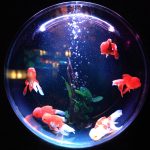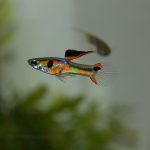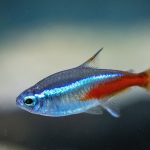The Ultimate Guide to Zebra Danios: Care, Breeding, and Behavior
Hey there, fish lovers! Today, we’re diving into the underwater world of zebra danios. These little guys are like living pieces of art in your aquarium. They’re super popular because they’re not just stunning to look at, but also really easy to take care of. In this guide, we’ll spill all the beans on zebra danios – from how to set up their perfect home to making sure they’re healthy and happy. So get ready to explore the ultimate guide to these charming aquatic buddies.
Understanding Zebra Danios
Physical Wonders
Zebra danios are like the little fashionistas of the fish world. They’re pretty small, about 1 to 2 inches long, and they’ve got these mesmerizing blue and silver stripes all over their bodies. It’s like they’re wearing a stylish zebra-patterned outfit all the time. These stripes make them stand out in any aquarium.
Where They Come From
Imagine a place with clear, flowing waters – that’s where zebra danios originally call home. They’re like the globetrotters of the fish world because they come from South Asia, particularly India, Nepal, and Bangladesh. These places have warm and tropical climates that zebra danios just love.
Social Swimmers
Zebra danios are total social butterflies, but in a fishy way! They’re known for their friendly and active behavior. These little guys are always on the move, zipping around the tank like they’re in a fishy race. They also like hanging out together, so having a few zebra danios in the same tank can make them feel like they’re in their own fishy party.
So, in this chapter, we’ve covered how zebra danios are like underwater fashionistas with their cool stripes, where they come from, and how they’re super social and active swimmers. Get ready to learn even more about these aquatic wonders.
Setting Up the Perfect Aquarium
Home Sweet Home
Alright, let’s talk about creating the dream home for your zebra danios. They might be small, but they still need their space. A tank that’s around 10 to 20 gallons is a good start. Now, who’s going to be their roommates? Zebra danios are friendly fellas, so they get along well with other peaceful fish like tetras or guppies. Just remember, no bullies allowed!
Getting the Water Right
Think of it this way – if zebra danios were planning a vacation, they’d choose a tropical paradise. So, you need to make sure their water is just right. Keep the temperature cozy between 65 to 77 degrees Fahrenheit (18 to 25 degrees Celsius). They like a slightly acidic to neutral pH, around 6.5 to 7.5. And don’t forget about water hardness, aim for 5 to 12 dGH.
Filtration and Cleanliness
Now, nobody likes living in a messy house, and neither do zebra danios. That’s why you need a good filter. A filter helps keep the water clean by removing all the gunk that can make your fishy friends sick. Regular water changes – about 25% of the water every couple of weeks – will also make sure your danios are swimming in a healthy environment.
So, in this chapter, we’ve talked about giving your zebra danios the right-sized home, picking suitable tank mates, setting up the perfect water conditions, and keeping their tank spick and span. Get ready to see those stripes shine in a happy and healthy habitat.
Feeding and Nutrition
Filling Their Tummies
Alright, it’s time to talk about what goes in those cute zebra danio tummies. These little swimmers are omnivores, which means they’re not picky eaters. They enjoy a mix of plant-based and protein-rich foods. So, let’s give them a balanced diet that keeps them swimming happily!
Food Variety
Just like we humans enjoy different types of food, zebra danios appreciate variety too. You can feed them high-quality flakes or pellets specially made for tropical fish. But wait, there’s more! They also love live and frozen treats like brine shrimp or daphnia. It’s like a gourmet meal for them.
Feeding Time Fun
Alright, here’s the scoop on feeding schedules. You can feed your zebra danios a small pinch of food twice a day. That’s usually enough to keep their bellies happy. Oh, and don’t go overboard – overfeeding can lead to a messy tank and unhealthy fish. Remember, moderation is the key to keeping your aquatic pals in tip-top shape.
So, in this chapter, we’ve chatted about giving your zebra danios a yummy diet full of flakes, pellets, live treats, and frozen goodies. Plus, we’ve covered how often to feed them and why portion control is essential. Get ready to see those little fishies nibble away happily.
Breeding and Reproduction
Fishy Love Story
Get ready for a fishy tale of love and reproduction! Zebra danios have a unique way of doing things. When they’re ready to make baby danios, the males show off their best colors and chase the females around. It’s like a dance party underwater! The females lay their tiny eggs, and the males fertilize them outside their bodies. Exciting, right?
Setting the Mood
If you want to be a matchmaker for your zebra danios, you’ll need a special place for them to get cozy. Create a separate breeding tank with plenty of plants and soft substrate. Add some marbles at the bottom to catch the falling eggs – this keeps them safe from hungry parents.
Egg-citing Times
Once the eggs are laid, it’s time to be a babysitter! Keep an eye on those eggs, making sure they’re not eaten by the adults. You might need to separate the parents to prevent them from snacking on their own eggs. After a few days, the eggs hatch into tiny fry. Feed them super small food like infusoria or powdered fry food. And remember, keep the water extra clean during this time.
So, in this chapter, we’ve delved into the fishy love story of zebra danios, how to create a perfect breeding environment, and taking care of the precious eggs and fry. It’s like being part of an underwater nursery! Get ready to witness the miracle of baby danios swimming around in their little world.
Health and Disease Management
Fish Wellness Check
Just like us, zebra danios can sometimes have health hiccups too. But don’t worry, we’ve got your back on how to keep them in the best shape possible. Some common issues they might face include fin rot, ich (those white spots), and swim bladder problems. It’s like going to the doctor, but fish-style!
Keep It Clean and Safe
Prevention is the name of the game when it comes to fish health. Regular water changes and maintaining the right water conditions we talked about earlier can go a long way in preventing health issues. Also, avoid overcrowding your tank – too many fish can stress everyone out.
Sick Fish SOS
Okay, so despite our best efforts, sometimes fish do get sick. If you notice any signs of illness, like lethargy, loss of appetite, or weird spots, it’s time for action. First, you might want to isolate the sick fish in a quarantine tank to prevent the illness from spreading. Then, depending on the issue, you might need to treat the water with medications or adjust the temperature.
So, in this chapter, we’ve covered how to be a fish health detective, ways to keep your aquarium a safe haven, and what to do if your zebra danios start feeling under the weather. Get ready to become a fish health superhero and give your aquatic buddies the best care they deserve.
Aquascaping and Tank Decorations
Creating Their Underwater World
Imagine your zebra danios swimming in a place that feels just like home. That’s what aquascaping is all about – designing their tank to resemble their natural habitat. Zebra danios love clear, flowing waters, so let’s give them a similar vibe in their tank.
Natural Touches
Plants, rocks, and hiding spots are like the furniture and decorations of their underwater home. Add some aquatic plants like Java moss or Vallisneria – they’ll provide hiding spots and oxygen for your fish pals. Smooth rocks and driftwood can give that natural riverbed feel. Don’t forget a cozy corner or two where they can take a break from all their swimming adventures.
Beauty Meets Comfort
Aquascaping isn’t just about making things look pretty; it’s about making your zebra danios feel at ease too. Arrange the plants and decorations in a way that gives them lots of open space to swim around while still having those cozy nooks for when they want some privacy.
So, in this chapter, we’ve dived into the art of aquascaping – making your zebra danios’ tank look like their dream home. We’ve talked about plants, rocks, and hiding spots that will not only make their habitat visually appealing but also ensure they feel comfortable and secure. Get ready to be an underwater interior designer for your fishy friends.
Breeding and Reproduction
Conditions for Breeding Success
Breeding zebra danios is like orchestrating a dance of nature. To trigger their breeding behavior, create a comfortable environment. Gradually increase the temperature to around 78-80°F (25-27°C) and provide a well-lit space. Regular water changes and nutritious food can also set the mood.
Preparing the Breeding Tank
Ready to play matchmaker? Set up a separate breeding tank, about 10-20 gallons in size. Fill it with clean, conditioned water. Add fine-leaved plants like Java moss or artificial spawning mops where the danios can lay their eggs. Marbles or a mesh can catch the eggs and prevent the parents from munching on them.
Egg-citing Egg Deposition
Watch the love story unfold as the females lay tiny, adhesive eggs on the plants or spawning mops. The males quickly fertilize them. After the process, you might notice the parents getting a bit protective, as they’ll guard their precious eggs.
Tending to the Tiny Fry
Within a few days, you’ll spot the eggs hatching into teeny-tiny fry. At this stage, they hang around their birthplace, absorbing their yolk sacs. After a couple of days, they’ll start swimming and looking for food. Feed them infusoria or powdered fry food, and as they grow, you can introduce finely crushed flakes.
Nurturing New Life
Caring for the fry requires keen attention. Keep their water super clean with gentle filtration. Gradually increase their food size as they grow. Watch in awe as the tiny fry transform into miniature versions of their parents, a testament to the wonders of nature’s cycle.
In this chapter, we’ve journeyed through the intricate process of breeding zebra danios, from setting the stage for their romance to the delicate care of their eggs and fry. Get ready to witness the miracle of new life and play a vital role in the continuation of these aquatic wonders.
Health and Common Issues
Spotting a Healthy Zebra Danio
A healthy zebra danio is a happy swimmer! Look for vibrant colors, active swimming, and fins held upright. Their appetite should be hearty, and they should interact with their tankmates. Observing these signs assures you that your aquatic buddies are in good shape.
Navigating Common Health Hiccups
Sometimes, even the healthiest fish can face challenges. Keep an eye out for telltale signs of trouble. White spots could indicate ich, while frayed fins might suggest fin rot. Lethargy, clamped fins, or loss of appetite might be signs of stress or illness. Swift action can make a big difference in their recovery.
Quarantine and Water Wellness
Before introducing new fish to your main tank, it’s wise to quarantine them first. This prevents potential diseases from spreading. A separate tank for quarantine allows you to monitor the newcomers for any signs of illness before they join your main tank. Also, maintaining consistent water conditions – regular water changes, proper filtration, and balanced parameters – is key to preventing health issues.
Promoting Lifelong Wellness
Maintaining a healthy environment is the ultimate gift you can give your zebra danios. Regularly check water parameters like temperature, pH, and ammonia levels. Avoid overfeeding, as uneaten food can lead to water quality problems.
In this chapter, we’ve explored the art of recognizing a healthy zebra danio, understanding common diseases, and the importance of quarantine and water quality management. By staying vigilant and proactive, you’re ensuring that your fishy friends enjoy a lifetime of swimming in the pink of health.
Tips for Successful Zebra Danio Keeping
Water Parameter Watch
Keeping a close eye on your zebra danios’ living conditions is like being their personal water detective. Regularly test and monitor water parameters like temperature, pH, ammonia, and nitrate levels. This detective work helps you catch any issues before they become fishy troubles.
Delicious and Diverse Diet
Variety is the spice of life – even for zebra danios! Offer them a mix of high-quality flake, pellet, live, and frozen foods. This diverse diet ensures they get all the nutrients they need to thrive. Plus, it keeps mealtime exciting and their fins wiggling with delight.
Shine a Light on Routine
Imagine having no sense of day or night – it’d be confusing, right? Well, your zebra danios feel the same way. Maintaining a consistent lighting schedule helps them establish a natural routine. Aim for 10-12 hours of light daily, replicating their natural day-night cycle.
By diligently monitoring water parameters, providing a yummy variety of food, and keeping their lighting schedule steady, you’re ensuring a happy and thriving life for your zebra danios. It’s like following a fish-friendly recipe for success.
Fun Facts and Trivia
Scientific Superstars
Zebra danios aren’t just pretty faces – they’ve played a big role in scientific research! These little fish have been used to study genetics and development. Their transparent embryos allow scientists to observe the growth of internal organs in real-time, providing valuable insights into human health and disease.
Wild Wonders
In their natural habitat, zebra danios are like underwater explorers. They’re skilled jumpers, often leaping out of the water to catch insects or avoid predators. They also have a social side – in the wild, they shoal together not only for protection but also to coordinate their movements and search for food.
Quirks and Charms
Zebra danios have some cool behaviors that set them apart. Ever noticed them “tapping” the water surface with their mouths? They’re actually eating tiny insects that got caught in the water tension. Also, these little swimmers are known for their distinctive “zig-zag” swimming style – it’s like they’re doing their own underwater dance routine.
Frequently Asked Questions (FAQ)
Q1: Are zebra danios suitable for beginners in fishkeeping?
A1: Absolutely! Zebra danios are often recommended for beginners due to their hardiness and adaptability. They’re a great choice for those new to fishkeeping.
Q2: Can zebra danios be kept with other fish in the same tank?
A2: Yes, zebra danios are social fish and can live harmoniously with other peaceful community fish like tetras, guppies, and rasboras.
Q3: How often should I feed my zebra danios?
A3: Aim to feed them a small amount twice a day. Be cautious not to overfeed, as excess food can lead to water quality problems.
Q4: What water conditions do zebra danios prefer?
A4: Zebra danios thrive in a temperature range of 65-77°F (18-25°C) and a slightly acidic to neutral pH of 6.5-7.5. They also prefer moderate water hardness.
Q5: How can I encourage breeding behavior in my zebra danios?
A5: Gradually increase the temperature to around 78-80°F (25-27°C) and provide well-lit conditions. Adding fine-leaved plants or spawning mops for egg deposition can trigger breeding behavior.
Q6: What should I do if my zebra danios show signs of illness?
A6: If you notice any unusual behavior, loss of appetite, or physical symptoms, isolate the affected fish and seek advice from experienced aquarists or aquatic veterinarians.
Q7: Can zebra danios jump out of the tank?
A7: Yes, zebra danios are known to be skilled jumpers. Make sure your tank has a secure lid to prevent any unplanned escapes.
Q8: How long do zebra danios live?
A8: With proper care, zebra danios can live around 3-5 years. Providing a suitable environment and attentive care can help extend their lifespan.
Q9: Can I keep zebra danios in a planted tank?
A9: Yes, zebra danios can thrive in a planted tank. They enjoy the hiding spots and shelter that plants provide.
Q10: How can I create a bond with my zebra danios?
A10: Spend time observing them and providing a consistent routine. They might become more comfortable with your presence over time, though they won’t interact with you in the same way as pets like dogs or cats.
Remember, every fishkeeping journey is unique, and these answers provide general guidelines. Adjust your care based on your specific circumstances and observations of your zebra danios.




